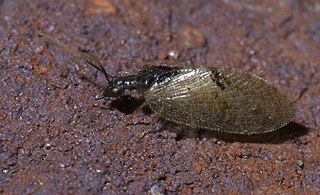
Sympherobius is a genus of brown lacewings in the family Hemerobiidae. There are at least 50 described species in Sympherobius.
Diplous californicus is a species of ground beetle in the family Carabidae. It is found in North America.
Henoticus californicus is a species of silken fungus beetle in the family Cryptophagidae. It is found in Central America, North America, and Europe.

Ectopsocus californicus is a species of outer barklouse in the family Ectopsocidae. It is found in Australia, Central America, and North America.
Sandalus californicus is a species of cicada parasite beetle in the family Rhipiceridae. It is found in North America.
Idiostatus californicus, or Pictet's shieldback, is a species of shield-backed katydid in the family Tettigoniidae. It is found in North America.
Sympherobius amiculus is a species of brown lacewing in the family Hemerobiidae. It is found in the Caribbean Sea and North America.
Parochodaeus californicus is a species of sand-loving scarab beetle in the family Ochodaeidae. It is found in North America.
Philodromus californicus is a species of running crab spider in the family Philodromidae. It is found in North America.
Enochrus californicus is a species of water scavenger beetle in the family Hydrophilidae. It is found in Central America and North America.

Sympherobius barberi, or Barber's brown lacewing, is a species of brown lacewing in the family Hemerobiidae. It is found in Europe and Northern Asia, Central America, North America, Oceania, and South America. The species was introduced to New Zealand to prey on aphids and mealybugs, first noted in 1936, however was not able to be established.
Valgus californicus is a species of scarab beetle in the family Scarabaeidae. It is found in Central America and North America.

Stenomorphus californicus is a species of ground beetle in the family Carabidae. It is found in North America.
Sympherobius killingtoni is a species of brown lacewing in the family Hemerobiidae. It is found in Central America and North America.
Boreus californicus is a species of snow scorpionfly in the family Boreidae. It is found in North America.
Cybocephalus californicus is a species of beetle in the family Cybocephalidae. It is found in North America. It can grow to be 0.95 mm to 1.30 mm in size.
Hippeutister californicus is a species of clown beetle in the family Histeridae. It is found in North America.
Xyonysius californicus, the California false chinch bug, is a species of seed bug in the family Lygaeidae. It is found in the Caribbean Sea, Central America, North America, and South America.
Ceracis californicus is a species of minute tree-fungus beetle in the family Ciidae. It is found in Central America and North America.
Cyclodinus californicus is a species of antlike flower beetle in the family Anthicidae. It is found in the Caribbean Sea, Central America, and North America.



